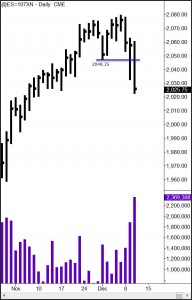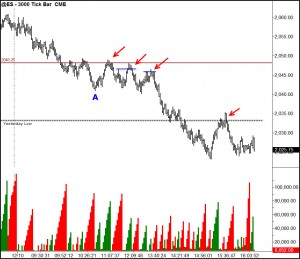Was it a Wyckoff Spring?
 Was it a Wyckoff Spring? That was the discussion in yesterday’s post. Because of the combination of Wyckoff principles that were setting up in the structure of the market, I expressed doubt that yesterday’s daily trading action in the S&P e-minis represented a sound Wyckoff Spring. Those doubts were confirmed today in spades as you can see on the daily chart.
Was it a Wyckoff Spring? That was the discussion in yesterday’s post. Because of the combination of Wyckoff principles that were setting up in the structure of the market, I expressed doubt that yesterday’s daily trading action in the S&P e-minis represented a sound Wyckoff Spring. Those doubts were confirmed today in spades as you can see on the daily chart.
The heart of the Wyckoff trading method is to understand supply and demand. We never simply accept a chart pattern–even a Wyckoff Spring–at face value. Structure and the supply-demand relationships expressed in price action, the waves and volume are what tell us about the likely next market move. Not chart patterns.
Failed Wyckoff Spring Trades
 As I mentioned in yesterday’s post, the last swing low at 2048.25 was the key level for whether or not yesterday’s price action was a sound Wyckoff Spring. Because of the heavy volume yesterday, we would expect the market to test around the 2048.25 level.
As I mentioned in yesterday’s post, the last swing low at 2048.25 was the key level for whether or not yesterday’s price action was a sound Wyckoff Spring. Because of the heavy volume yesterday, we would expect the market to test around the 2048.25 level.
By the first hour of the US trading session, the market had fallen more than seven points below 2048.25. We see this on the 3,000 tick chart at A. That’s not a test and we knew at that point that the Wyckoff Spring was in serious trouble.
That size of a drop underneath a key level with the level of volume we saw usually means that that key level will become resistance on any approach back up. That is exactly what happened today, giving traders ample opportunities to get short (red arrows). This is a standard Wyckoff Trading Method setup with a target of yesterday’s low or lower.
Wyckoff Spring Low Becomes Resistance
We can see that volume favored sellers all day. Late in the day a final short set up on very weak demand at the top of the rally into yesterday’s low. This is another standard Wyckoff Trading Method play. Even though it occurred very late in the trading day, it produced a sizable number of points.
Deep Practice
Learning to read the market like this is not difficult to learn, but does take some effort and practice. Every week, I meet with a group of like-minded traders in our specialty Deep Practice program. Deep Practice presents market situations like we saw over the past few days with an aim of developing in participating traders the skills needed to assess and successfully trade what is seen on the chart. Wyckoff market principles are taught each week with discussion and simulated examples. Based on over 40 years of performance psychology that has uncovered what makes great performers great, we use the psychological principles of deliberate practice to rapidly build knowledge, skills and abilities in our traders. Learn more at this link: Deep Practice

Leave a Reply